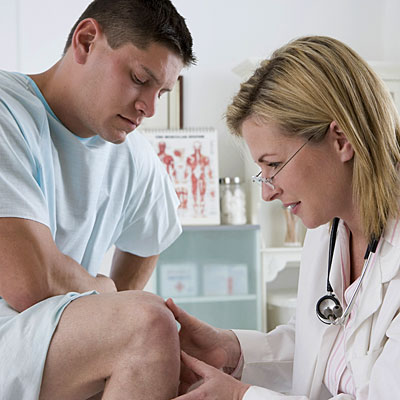Psoriatic arthritis is a chronic condition in which the immune system attacks the body, causing joint pain and other symptoms. It tends to develop in people with psoriasis.
"The most important thing for these patients is early recognition, diagnosis, and treatment of the disease," says Elaine Husni, MD, vice chair of the Department of Rheumatic and Immunologic Diseases at the Cleveland Clinic.
Many symptoms mimic other conditions or arthritis types, so psoriatic arthritis can be missed or misdiagnosed.
Here are some risk factors and symptoms
1. Age and gender
Psoriatic arthritis can show up at any age (even in children), but it appears most frequently between 30 and 50. There are five types and men and women are equally likely to get it. About 1 million people in the U.S. have psoriatic arthritis, but there’s no single blood test for it. (There are more than 100 kinds of arthritis and joint-pain conditions, including fibromyalgia, gout, degenerative joint disease, and bursitis.) The most common is osteoarthritis. About 27 million Americans have this type, which is caused by wear and tear of the joints, not an immune reaction.
2. Scaly skin
Up to 7.5 million Americans have psoriasis, an autoimmune disease that results in scaly skin patches. As many as 30% of people with psoriasis eventually develop psoriatic arthritis. For most people, psoriasis symptoms occur about 5 to 10 years before arthritis. In some cases, the arthritis shows up first. In 10% of people, psoriasis and arthritis are diagnosed simultaneously. The severity of psoriasis doesn’t predict psoriatic arthritis. Some psoriasis symptoms are so mild or easy to overlook that people can be mistakenly diagnosed with osteoarthritis or other types of arthritis.
3. Joint trouble
People with psoriatic arthritis may experience stiff, painful joints that are red and warm to the touch. Morning stiffness can be a particular problem. Such joint problems can be mistaken for rheumatoid arthritis, which is also caused by an autoimmune attack, says Dr. Husni. Like other autoimmune conditions, symptoms tend to flare and subside, only to flare again later on. Psoriatic arthritis is incurable, but treatable. Symptoms can be mild or severe, and may lead to joint destruction, which can require joint replacement surgery.
4. Asymmetrical pain
Although not always the case, psoriatic arthritis tends to affect large joints in the legs, like the knees and ankles, or the fingertips. The pain is often asymmetrical; one knee may be affected but not the other. In contrast, rheumatoid arthritis is often symmetrical, affecting both wrists at the same time, for example. There are five subtypes of psoriatic arthritis. Four are asymmetrical, and they account for about 80% of cases, says Stephen Paget, MD, rheumatologist and physician-in-chief emeritus at Hospital for Special Surgery, in New York City.
5. Swollen fingers
Dactylitis, or swelling in the fingers and toes, occurs in about 40% of patients with psoriatic arthritis. Because this symptom is much less common in other types of arthritis, it can help doctors distinguish between psoriatic arthritis and other conditions like rheumatoid arthritis. Dactylitis is caused by inflammation of the entire tendon that runs along the fingers or toes. Such "sausage" toes or fingers can occur before someone even has joint problems.
6. Foot pain
Psoriatic arthritis can cause pain and swelling beyond the joints. Enthesitis is inflammation of an area where a tendon or ligament connects to bone. If it happens in the foot, it can be misdiagnosed as plantar fasciitis or heel spur, both of which tend to arise from overuse or injury. People with rheumatoid arthritis may also have foot pain, as do those with lupus, another autoimmune condition. Psoriatic arthritis can look like, or be associated with, gout, an arthritis that causes joint pain, often in the big toes.
7. Fingernail and toenail pitting
Psoriatic arthritis can cause fingernails and toenails to become discolored or pitted (small depressions form in the nail), or even fall off. This can happen with distal interphalangeal arthropathy, one of the five types of psoriatic arthritis. This type mostly affects the joints at the end of the fingers and toes, in addition to the nails. It occurs in only 5% of patients, and is more common in men than women. Because nail changes are specific to psoriatic arthritis (and psoriasis), it can help doctors diagnose the conditions.
8. Back trouble
People with psoriatic arthritis often experience back problems along with other symptoms, Dr. Husni says. Pain can occur when there is inflammation and stiffness in the spine, neck, or pelvis, or in the tendons and ligaments that attach to the spine. About 1 in 5 people with psoriatic arthritis have a type called psoriatic spondylitis, in which the spinal bones fuse. In about 5% of people, spinal symptoms are the only manifestation of psoriatic arthritis.
9. Fatigue
Like other autoimmune conditions, psoriatic arthritis can cause fatigue. Many factors can contribute to this exhaustion, and a 2010 study found—perhaps not surprisingly—that patients with more pain, physical disability, and psychological distress were more likely to feel fatigue than those with less. Fatigue is also a result of the inflammation that arthritis causes. "Medications usually make it better because you’re treating the underlying conditions," Dr. Husni explains.
10. Eye problems
People with psoriatic arthritis can experience eye inflammation known as conjunctivitis or iritis. This can cause blurry vision; eyes may be painful, red, and sensitive to light. However, other types of autoimmune conditions, such as rheumatoid arthritis and multiple sclerosis, can cause vision problems as well.
11. Finger deformities
Psoriatic arthritis can sometimes cause flexion deformity, in which fingers are pulled out of their normal alignment. About 5% of people with psoriatic arthritis develop the most severe form of the disease, called psoriatic mutilans. Without treatment, this can cause destruction of multiple joints, often in the hands, feet, neck, and lower back. When it affects the hands, it can cause telescoping fingers. This occurs when finger bones are reabsorbed into the body, causing tissue collapse. The fingers can shrink down into themselves in a telescoping fashion.
Source: www.health.com







